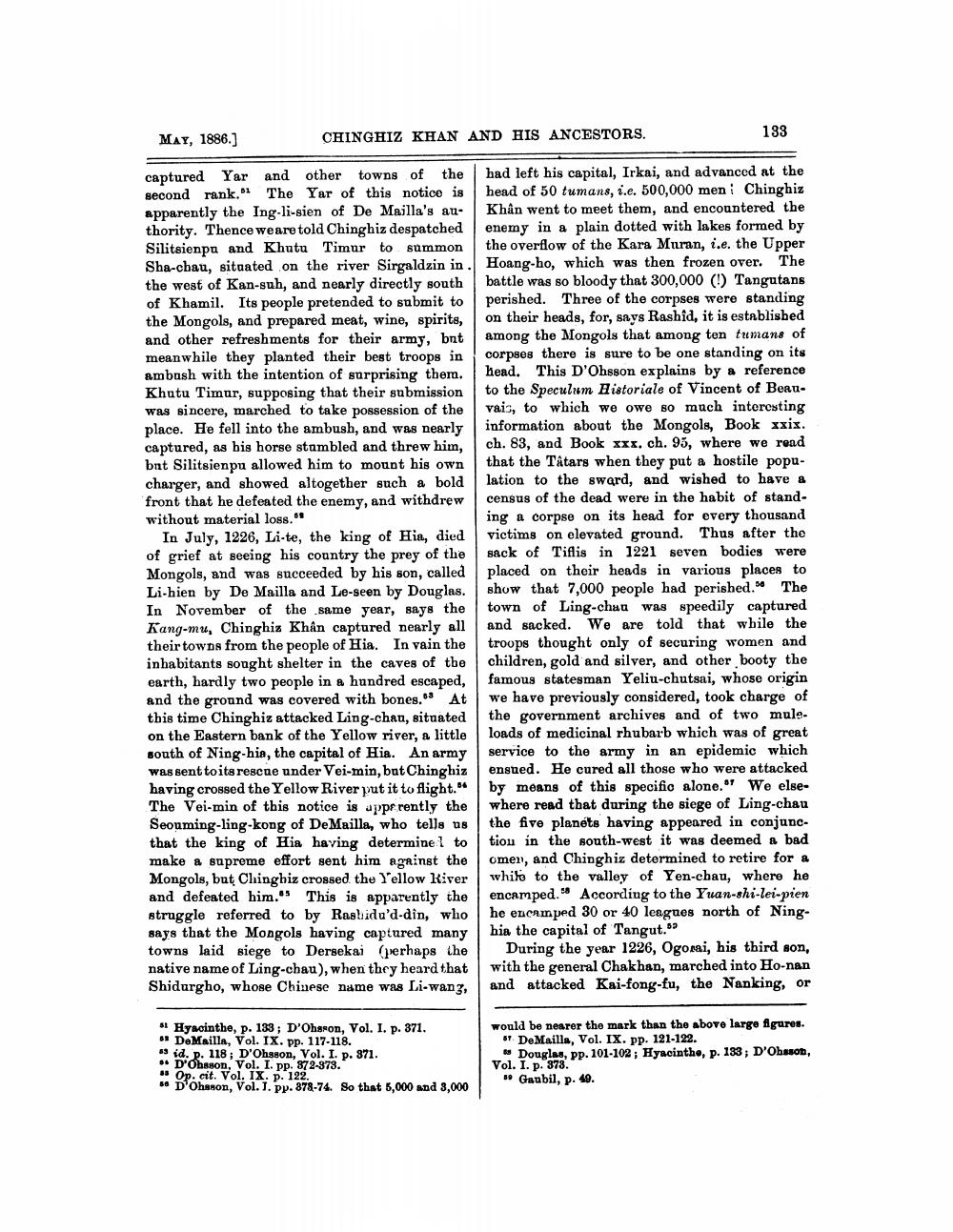________________
MAY, 1886.)
CHINGHIZ KHAN AND HIS ANCESTORS.
133
captured Yar and other towns of the had left his capital, Irkai, and advanced at the second rank." The Yar of this notice is head of 50 tumans, i.e. 500,000 men i Chinghiz apparently the Ing-li-sien of De Mailla's au- Khân went to meet them, and encountered the thority. Thence we are told Chinghiz despatched enemy in a plain dotted with lakes formed by Silitsienpa and Khutu Timur to summon the overflow of the Kara Muran, i.e. the Upper Sha-chau, situated on the river Sirgaldzin in. Hoang-ho, which was then frozen over. The the west of Kan-suh, and nearly directly south battle was so bloody that 300,000 (1) Tangutans of Khamil. Its people pretended to submit to perished. Three of the corpses were standing the Mongols, and prepared meat, wine, spirits, on their heads, for, says Rashid, it is established and other refreshments for their army, but among the Mongols that among ten tumans of meanwhile they planted their best troops in corpses there is sure to be one standing on its ambush with the intention of surprising them. head. This D'Ohsson explains by a reference Khutu Timur, supposing that their submission to the Speculum Historiale of Vincent of Beauwas sincere, marched to take possession of the vais, to which we owe so much interesting place. He fell into the ambush, and was nearly information about the Mongols, Book xxix. captured, as his horse stumbled and threw him, ch. 83, and Book xxx, ch. 95, where we read but Silitsienpu allowed him to mount his own that the Tatars when they put a hostile popucharger, and showed altogether such a bold lation to the sword, and wished to have a front that he defeated the enemy, and withdrew census of the dead were in the habit of standwithout material loss."
ing a corpse on its head for every thousand In July, 122, Li-te, the king of Hin, died victims on elevated ground. Thus after the of grief at seeing his country the prey of the sack of Tiflis in 1221 seven bodies were Mongols, and was succeeded by his son, called placed on their heads in various places to Li-hien by De Mailla and Le-seen by Douglas. show that 7,000 people had perished. The In November of the same year, says the town of Ling-chau was speedily captured Kang-mu, Chinghiz Khân captured nearly all and sacked. We are told that while the their towns from the people of Hia. In vain the troops thought only of securing women and inhabitants sought shelter in the caves of the children, gold and silver, and other booty the earth, hardly two people in a hundred escaped, famous statesman Yeliu-chutsai, whose origin and the ground was covered with bones. At we have previously considered, took charge of this time Chinghiz attacked Ling-chan, situated the government archives and of two mule. on the Eastern bank of the Yellow river, a little loads of medicinal rhubarb which was of great south of Ning-hin, the capital of Hia. An army service to the army in an epidemic which Was sent toits rescue under Vei-min, but Chinghiz ensued. He cured all those who were attacked having crossed the Yellow River put it to flight." by means of this specific alone." We elseThe Vei-min of this notice is apprrently the where read that during the siege of Ling-chau Seouming-ling-kong of De Mailla, who tells us the five planets having appeared in conjuncthat the king of Hia having determinel to tion in the south-west it was deemed a bad make a supreme effort sent him against the omen, and Chinghiz determined to retire for a Mongols, but Chinghiz crossed the Yellow River whilo to the valley of Yen-chau, where he and defeated him." This is apparently the encamped." According to the Yuan-shi-lei-pien struggle referred to by Rashidu'd-din, who he encamped 30 or 40 leagues north of Ningsays that the Mongols having captured many hia the capital of Tangut." towns laid siege to Dersekai Gerhaps the During the year 1226, Ogonai, his third son, native name of Ling-chau), when they heard that with the general Chakhan, marched into Ho-nan Shidurgho, whose Chinese name was Li-wang, and attacked Kai-fong-fu, the Nanking, or
#1 Hyacinthe, p. 133; D'Ohsson, Vol. I. p. 371. * De Mailla, Vol. IX. pp. 117-118. *s id. p. 118; D'Ohsson, Vol. I. p. 371. . D'Ohsson, Vol. I. pp. 872-873.
Op. cit. Vol. IX. p. 122. 56 D Ohanon, Vol. J. Pp. 878-74. So that 5,000 and 3,000
would be nearer the mark than the above large figures. 6DeMailla, Vol. IX. pp. 121-122.
Douglas, pp. 101-102 ; Hyacinthe, p. 133; D'Obsson, Vol. I. p. 378.
Gaubil, p. 49.




